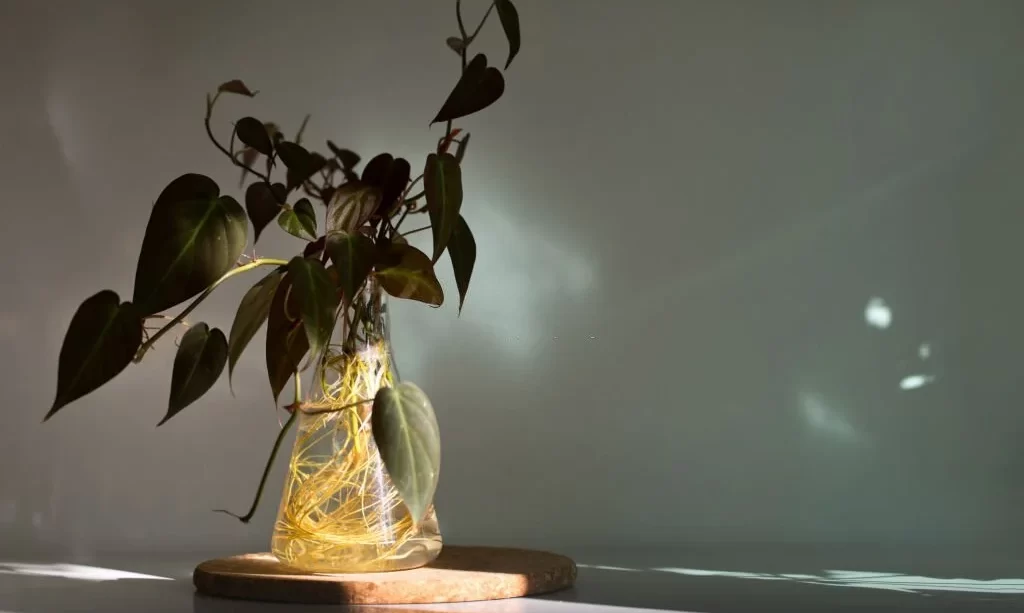Philodendron plants are cherished for their lush, tropical foliage, making them a popular choice among indoor gardeners. These green beauties can transform any living space into a tropical oasis. While many grow Philodendron in traditional soil-based pots, there’s an intriguing and visually captivating alternative: growing Philodendron in water. In this article, we will explore the art of cultivating Philodendron in water, a practice that not only adds a touch of greenery to your home but also simplifies maintenance and offers unique aesthetic appeal. Let’s dive into the world of water propagation for Philodendron and discover how you can bring this tropical wonder into your living space with ease.
- Pink Princess Philodendron is a living work of art: Each leaf is unique! Most leaves are marked with a bit of pink. Some have a little, others have a lot. The more it grows, the more potential it has
- Height is approximately 10-12 inches tall, measured from the bottom of the pot to the top of the plant. It is in a 6-inch diameter composite material planter
- Grow Philodendron Pink Princess in bright, indirect sunlight for the best growth and enjoy!
- Water Philodendron Pink Princess with approximately 1/2 cup of water about once a week. Adjust as needed for your environment
- Enjoy it as it grows. Every leaf will have a different amount and pattern of pink variegation (some may be all-green). Watch it become larger and more beautiful as it matures
Why Grow Philodendron in Water?
Growing Philodendron in water offers a range of compelling benefits that make it an attractive choice for indoor gardeners:
- Improved Indoor Air Quality: Philodendron plants are renowned for their air-purifying qualities. By growing them in water, you can enhance the quality of the air in your home, removing toxins and providing a fresher, healthier environment.
- Reduced Maintenance: Water propagation simplifies the care routine for Philodendron. It eliminates the need for regular soil maintenance, such as repotting or worrying about soil pests.
- Aesthetic Appeal: Philodendron plants growing in clear glass containers with their roots submerged in water create a visually stunning display. It’s a unique and attractive way to showcase these tropical plants in your home.
- Sustainability: Water propagation allows you to propagate new Philodendron plants sustainably. You can grow new plants from cuttings, reducing the need for purchasing additional ones.
Choosing the Right Philodendron Variety
Selecting the right Philodendron variety is essential for successful water propagation. Consider the following factors:
- Heartleaf Philodendron (Philodendron hederaceum): This popular variety is well-suited for water propagation. Its heart-shaped leaves and vigorous growth make it an attractive choice for indoor water gardens.
- Pothos (Epipremnum aureum): While not a true Philodendron, Pothos, also known as Devil’s Ivy, shares similar characteristics and thrives in water. Its striking variegated foliage adds visual interest.
- Monstera (Monstera deliciosa): Monstera plants, with their unique split leaves, can also be propagated in water. They make a bold statement in water-filled vases or containers.
- Select Other Varieties: Some other Philodendron species and cultivars can also be grown in water. Consult with local nurseries or horticultural experts for recommendations based on your preferences and local conditions.
By choosing the right Philodendron variety, you set the stage for a successful and visually appealing water propagation experience.
- LIVE INDOOR PLANT – Brighten someone’s day with a Pink Princess Philodendron! Perfect for home décor, this living houseplant features burgundy and bright Pink leaves. It will add color and excitement to any space!
- BEST VALENTINE’S DAY GIFT – Say “I Love You” with a beautiful Pink plant! This plant is perfect for Valentine’s Day, Mother’s Day, anniversaries, or just because! Take advantage of our special plant delivery and let someone special know you love them.
- SAFE SHIPPING – Our team hand selects the high-quality plants and carefully packages them with innovative air cells, plant stakes, and other materials needed to ensure they arrive in great condition!
- HEALTHY PLANT – We grow healthy plants with mid to high variegation, strong root systems, and full composition. We also use sustainable growing practices and annually receive an A-Rating from the MPS-ABC Environmental Certification.
- EASY TO GROW – This Pink Princess Philodendron is easy to grow. It likes watered when the soil is almost dry and prefers bright, indirect sunlight. With proper care, Pink Princess Philodendron can last for years!
Preparing the Water and Container
Successful water propagation of Philodendron begins with proper water and container preparation:
- Clean, Chlorine-Free Water: Use clean, chlorine-free water for your Philodendron cuttings. Chlorine can harm the plants, so you can either use filtered water, let tap water sit for 24 hours to allow chlorine to dissipate, or use dechlorinated water.
- Selecting the Container: Choose a clear glass container, vase, or jar that allows you to see the roots growing. The transparency adds to the visual appeal of your water-grown Philodendron. Ensure that the container is clean and free from contaminants.
- Water Level: Fill the container with enough water to submerge the Philodendron cuttings’ nodes where roots will develop. Leave a small gap between the water surface and the top of the container to allow for oxygen exchange.
Taking Philodendron Cuttings
Taking healthy Philodendron cuttings is a critical step in water propagation:
- Select Healthy Stems: Choose healthy stems with at least one node, which is a small bump on the stem where roots will emerge. Nodes are typically found where leaves are attached to the stem.
- Pruning Shears or Scissors: Use sharp, clean pruning shears or scissors to make a clean cut just below a node. Each cutting should be around 4-6 inches in length.
- Remove Lower Leaves: Trim or remove any leaves from the lower portion of the cutting that would be submerged in water to prevent decay.
Propagating Philodendron in Water
Here’s how to propagate Philodendron in water:
- Place Cuttings in Water: Carefully place the Philodendron cuttings in the prepared container, ensuring that the nodes are submerged in water. You can place multiple cuttings in the same container, leaving some space between them.
- Change Water Regularly: Change the water every 1-2 weeks or when it becomes cloudy to maintain water quality and prevent rot. Rinse the container thoroughly before refilling with fresh water.
- Location: Position the container in a location with indirect sunlight, as direct sunlight can lead to algae growth in the water. Ensure that the cuttings receive adequate ambient light.
- 100% NATURAL: Special blend ideal for Heartleaf Philodendrons, Red Leaf Philodendrons, Brasil Philodendrons, Elephant Ear Philodendron and Much More
- USES: Specially formulated for growing healthy philodendron plants in containers
- Benefits: Organic humus, excellent drainage, nutrient retention, water retention, and pH balance
- Ingredients: Peat moss, pine bark, worm castings, perlite, and lime
- Size: 8 quarts (enough for a big 12-inch pot)
Monitoring Growth and Root Development
To ensure successful propagation, monitor the growth and root development of your Philodendron cuttings:
- Patience Is Key: It may take several weeks or even months for roots to develop, depending on factors like temperature and humidity. Be patient and avoid disturbing the cuttings.
- Healthy Roots: Look for the emergence of white, healthy roots from the nodes. This is a sign that your Philodendron cuttings are establishing themselves in water.
- Transplanting: Once the roots are several inches long and well-developed, you can choose to transplant your Philodendron cuttings into soil-based pots if desired. Otherwise, they can continue to thrive in water indefinitely.
By following these steps, you can successfully propagate and grow Philodendron in water, enjoying the beauty of their lush foliage without the need for soil.
Transplanting Philodendron Cuttings
Transplanting your Philodendron cuttings into soil-based pots is optional but can be a rewarding step:
- Soil Preparation: Select a well-draining potting mix suitable for houseplants. Fill a clean, appropriately sized pot with the soil, leaving enough space to accommodate the root system of your Philodendron cuttings.
- Transplanting: Gently remove the Philodendron cuttings from the water, being careful not to damage the fragile roots. Dig a small hole in the soil and place the cutting, ensuring that the roots are covered. Water thoroughly after transplanting.
- Acclimation: Initially, place the newly transplanted Philodendron in a location with indirect light to allow it to acclimate to soil conditions. Gradually increase the exposure to brighter light over a few weeks.
- ARE YOU STARVING YOUR PHILODENDRON? Feed your philodendron essential nutrients to grow healthy and strong. Houseplant Resource Center’s gentle plant food is specially formulated as a philodendron fertilizer, providing key elements for growth, improving nutrient uptake, and correcting soil deficiencies.
- THE PERFECT MULTIVITAMIN: Grow big, bold houseplants with the ideal N-P-K ratio (3% nitrogen, 3% available phosphate, 3% soluble potassium) for your philodendron. Good for growing your houseplant both indoors and outdoors. Our liquid fertilizer is all purpose and suitable for other indoor potted plants. It does a great job as a monstera fertilizer!
- BIOSTIMULANT BLEND: Humic-fulvic acid and sea kelp extract are a plant’s best friends, boosting nutrient uptake for hearty rooting and vibrant color.
- EASY TO USE – NO MIXING OR MESS! Gentle enough to use every time you water. Dilute one teaspoon into a cup or more of water before your plant’s weekly watering. It makes plant care simple!
- INCLUDES FREE PHILODENDRON CARE WEBINAR AND E-BOOK with your purchase that will help you grow the perfect philodendron in your home and troubleshoot any problems you may be having.
Care and Maintenance
Proper care ensures the continued health and vibrancy of your water-grown Philodendron:
- Light: Provide bright, indirect light to your Philodendron. Avoid direct sunlight, as it can scorch the leaves.
- Water: Maintain the water level in your container, keeping the nodes submerged. Change the water every 1-2 weeks to prevent stagnation.
- Pruning: Regularly trim yellowing or dead leaves to encourage new growth and maintain an attractive appearance.
- Fertilization: Feed your Philodendron with a balanced, water-soluble fertilizer during the growing season (spring and summer). Follow the product’s instructions for dilution and frequency.
- Repotting: If you choose to keep your Philodendron in water indefinitely, refresh the water and clean the container as needed. If you transplanted your cuttings into soil, repot them into larger containers as they outgrow their current pots.
Troubleshooting Common Issues
Addressing common problems ensures the health and vitality of your water-grown Philodendron:
- Yellowing Leaves: Yellowing leaves may indicate overwatering, poor water quality, or insufficient light. Adjust your care routine accordingly.
- Root Rot: If you notice slimy, dark-colored roots, your Philodendron may be suffering from root rot due to waterlogged conditions. Trim affected roots and change the water to prevent further rot.
- Algae Growth: Algae can develop in the water, especially in direct sunlight. Reduce the light exposure or change the water more frequently to control algae growth.
- Stagnant Growth: If your Philodendron isn’t growing or developing roots, ensure that it receives sufficient indirect light and maintain water quality by changing it regularly.
Conclusion
Growing Philodendron in water is a captivating and low-maintenance way to enjoy these lush, tropical plants. Whether you choose to keep them in water indefinitely or transplant them into soil, water propagation offers an opportunity to showcase their beauty in a unique and visually appealing manner. With proper care and attention, your water-grown Philodendron can thrive and bring a touch of green serenity to your indoor space. Explore the world of water propagation and embark on a rewarding journey of nurturing these vibrant houseplants.








